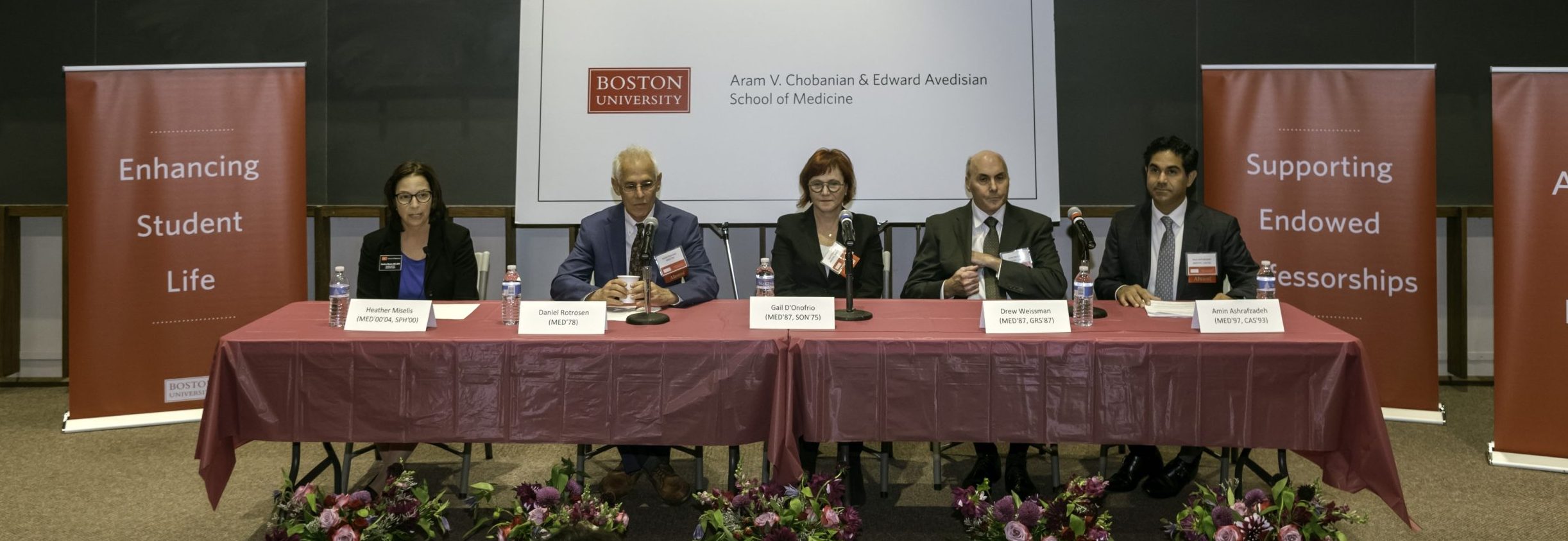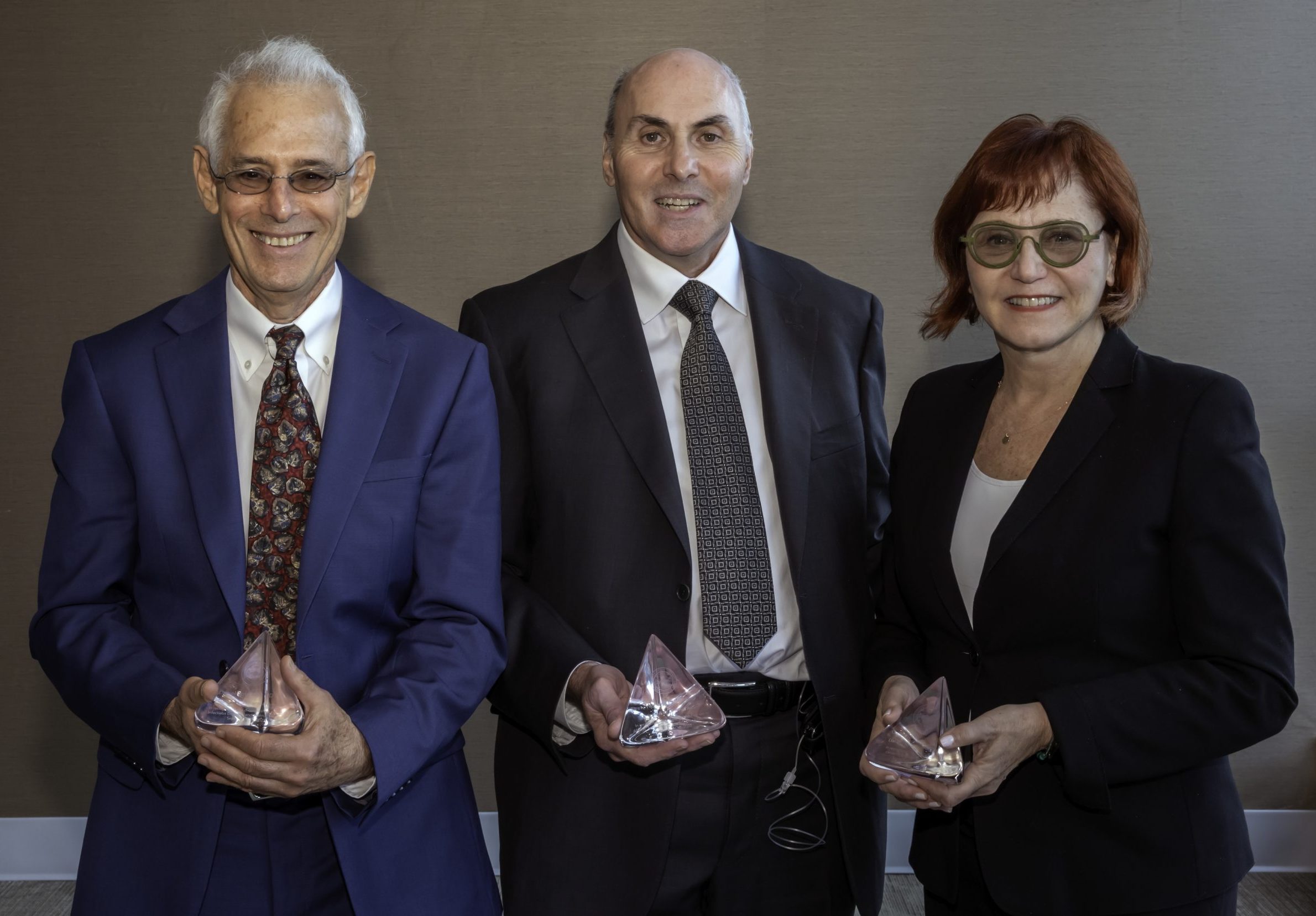Alumni Weekend Featured Reunions, Food, Discussions
Alumni Weekend opened on Thursday, Sept. 29, with the surprise announcement of a transformational $100 million gift to the medical school and its formal renaming as the Aram V. Chobanian & Edward Avedisian School of Medicine.
The backstory was especially heartwarming, with BU Alumnus Avedisian (CFA’59, ’61), a longtime clarinetist with the Boston Pops and Boston Ballet orchestra and a savvy investor, making the donation to honor his longtime childhood friend Chobanian (Hon.’06), a noted cardiologist, former medical school dean and university president emeritus.
 L to r Heather Miselis, Daniel Rotrosen, Gail D’Onofrio, Drew Weissman, Amin Ashrafzadeh
L to r Heather Miselis, Daniel Rotrosen, Gail D’Onofrio, Drew Weissman, Amin Ashrafzadeh
Friday featured an insightful panel discussion and Distinguished Alumni Awards luncheon, which honored this year’s recipients Drew Weissman, MD, PhD (MED’87, GRS’87), Roberts Family Professor of Vaccine Research at the University of Pennsylvania’s Perelman School of Medicine; Gail D’Onofrio, MD, MS (MED’87), Albert E. Kent Professor of Emergency Medicine at Yale School of Medicine; and Daniel Rotrosen, MD (MED’78), director of the division of allergy, immunology and transplantation at the National Institute of Allergy and Infectious Diseases (NIAID).
The morning panel discussion was held in-person in Keefer Auditorium and also live-streamed. Assistant Dean for Alumni Affairs Heather Miselis, MD, MPH, (MED’00, MED’04, SPH’04) and Alumni Association President Amin Ashrafzadeh, MD (CAS’93, MED’97), co-moderated the conversation with the three Distinguished Alumni Award recipients.
With two immunologists on the panel, the conversation naturally gravitated toward COVID-19. Weissman was optimistic about the applications of nucleoside-modified messenger RNA platforms.
“It’s going to be applied to a huge number of vaccines,” he said. It was already employed for vaccines headed to human clinical trials for HIV, influenza and genital herpes and to develop vaccines targeting noroviruses and malaria.
But it’s also being used for gene therapy, especially in connection with sickle cell anemia.
“What we’re developing will be a single injection that will target the bone marrow and cure the disease,” he told the audience.
Rotrosen said COVID made his agency pivot from mouse to human immunological trials wherever possible. “That set us up for this explosion of research and important findings…on how the human immune system works,” he said.
D’Onofrio’s work targets the opioid crisis’ impact on emergency rooms.
“There isn’t any other disease that causes so much death in the emergency room. Probably having a huge heart attack is the only thing that comes close,” D’Onofrio said. Her goals include changing national policies on opioids and introducing new interventions.
“The pandemic has really made all substance abuse disorders go out of control,” she said. “More people are using more drugs and more people are vulnerable than ever before.”
COVID-19 worsened an already escalating opioid crisis. One of the big questions for D’Onofrio is why so many people forgo treatment following a non-fatal overdose, despite statistics showing that five percent of overdose survivors die within a year and would have a much higher survival rate with treatment.
COVID also exposed weaknesses in healthcare, exacerbating existing inequities in treatment and accessibility for marginalized populations. These inequities were something all three panelists witnessed in their medical school training and in clinical rotations at the School’s primary teaching affiliate Boston Medical Center (which was then known as City Hospital).
“Equity has always been important and a driving force in my career,” said Weissman.
D’Onofrio said her exposure to urban healthcare through her medical school training and clinical work at City Hospital was the foundation of her life work addressing addiction and substance abuse as underlying causes for the emergency room caseload.
“You couldn’t have had better training than we had,” she said.
“I learned so much from the patients,” said Rotrosen, who appreciated that the medical school and hospital encouraged students to participate in patient care. His medical school experience of traveling with physicians to see geriatric patients in their homes moved him, he said.
That experience stuck with him and NIAID has an asthma program in which physicians do home visits.
“Children, women, in urban areas suffer disproportionately from asthma and we’ve made major advances in our understanding, not just of the biology but of the socioeconomic demographic factors,” Rotrosen said.
 L to R Daniel Rotrosen, Drew Weissman, Gail D’Onofrio
L to R Daniel Rotrosen, Drew Weissman, Gail D’Onofrio
The awards luncheon was an in-person celebration of the many accomplishments of the recipients. Each was introduced by Alumni Association President Ashrafzadeh and presented with a crystal sphere engraved with their names.
At the luncheon’s conclusion, Heidi Abdelhady, MD (MED’98) was introduced as the incoming alumni association president.
“I’m grateful for this opportunity,” Abdelhady said. “I’m humbled by this community as I look at the alumni in this room. I can’t say it enough that my mind is absolutely blown by the three people (D’Onofrio, Weissman, Rotrosen) getting awards today. They not only contributed to science but they actually changed our lives for the better.
“I’m excited for the year ahead.”
Other special alumni events included reunion dinners, including the 50th Reunion Dinner for the Class of ’72; tours of campus landmarks like the new Instructional building team-based Learning Center on L4 and the newly renovated Gross Anatomy Lab.
View all posts